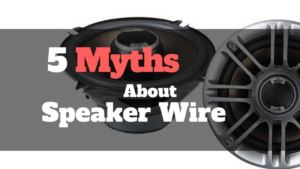 Most times people ask me questions like “for best car speaker sound, is it best to buy expensive speaker wires for my speakers? “.
Most times people ask me questions like “for best car speaker sound, is it best to buy expensive speaker wires for my speakers? “.
“Can Casual listeners or audiophiles upgrade their audio system by improving its simpler component—the connectors?”
Some company adverts claim that yes it can be done. This has made them bring to the market expensive speaker cables that boost of better sound quality, and excellent melody free of healthy grain.
However, almost all of these claims are just myths circulating speaker cables. We list five of these myths:
Table of Contents
Thicker Cables are Best
Though it’s accurate information for reducing resistance effects, thicker wires are best. However, some setups with speakers within the range of 100 ft away from the amplifier, a lamp cord of 16-gauge are excellent.
Experts suggest that for speakers about 100-200 ft. Apart from its amp, a 14-gauge cable is suitable.
Finally,
and most recommended for 200-400 ft. is the 12-gauge cables. When you purchase thick wires or rather extremely thick wires for brief runs, you don’t get any clear benefit, even if you do like some ads claim you won’t be able to hear them anyway, so what’s the point?.
Resolving Skin Effect
Signals of higher frequencies seem to navigate on the perimeter of a wire while signals of lower frequencies navigate around the center. It’s best not to waste any additional funds trying to solve this problem because the skin mentioned above effect is significant when using long cables and frequencies not meant for audio.
Speaker Cables Should have Equal Length
It makes sense right?
Yes, we agree with you that to banish phase shifts, speaker cables need to be of equal length.
However, via the speaker cables, electric signals move at almost light speed. This speed of light travelling means that it would require miles of speaker cables before any difference can be detected. Yes, we are saying a minor variation of about 10 foot is irrelevant.
Break-in is “Crucial”
LOL, I always laugh when I listen to my friends arguing about this. This myth was invented as a money-making technique by companies using the self-acclaimed audio experts.
This myth states that currents (electrical) moving through speaker cables alters the cables physically to spawn an audible change over some time. Do I still need to tell you that this is not true?
Of course, it’s false information.
The Sound Quality is Degraded by Splice
It’s already determined by audio professionals that well soldered or spliced wires doesn’t alter or degrade the quality of sound emancipating from speakers.
An electrical tool called the oscilloscope can be used to detect splices, these spikes or slightly drops are very low to hear with the human ear.
Voltage meant for powering speakers is just a simple one, and this means that frequent fluctuations are resulting from the frequency and program type happen during standard use, no audible effect if produced by splices to alter your sound quality.
Enjoyed the article? If you did and had any other myths you might want to bring to the table, you can use the comment box.